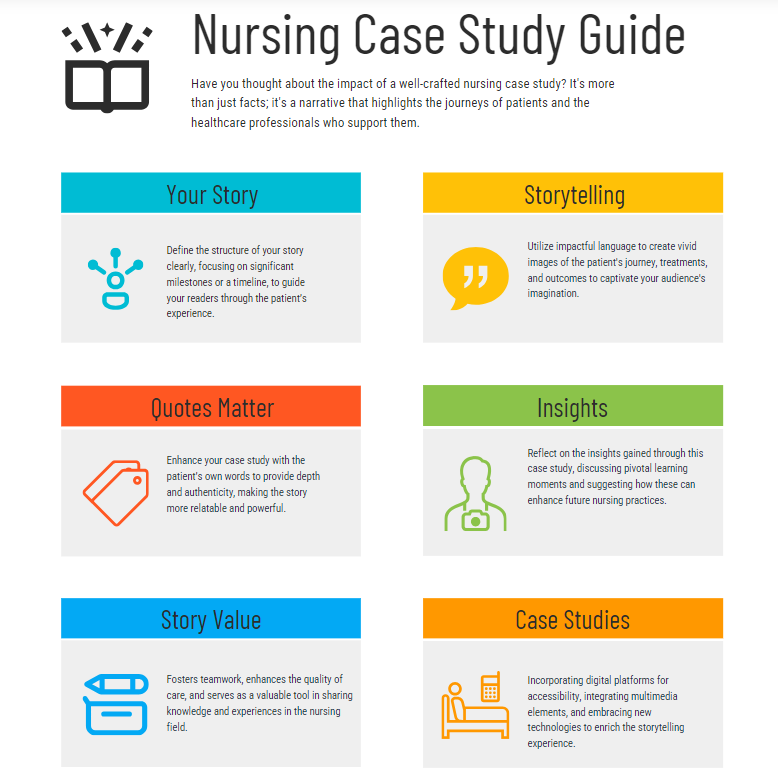
Table of Contents
In the dynamic world of nursing, the art of storytelling through case studies is a powerful tool. Case studies for nursing offer a unique platform to delve into real-life scenarios, analyze clinical challenges, and showcase the application of nursing knowledge and skills. Whether you are a student crafting a case study for an assignment, a nurse documenting a significant experience, or a researcher investigating a specific patient population, crafting a compelling case study is crucial for capturing attention and facilitating learning.
This comprehensive guide will walk you through the essential steps involved in writing a successful case study for nursing, highlighting strategies to enhance your writing and make your work stand out.
Steps to Writing a Compelling Case Study for Nursing
1. Selecting and Defining the Case:
The foundation of a strong case study for nursing lies in selecting a relevant and compelling case. Here’s how to approach this crucial step:
- Identify a Focus: Choose a clinical scenario that resonates with your learning objectives or research interests. This could be a specific patient with a unique condition, a challenging ethical dilemma, a successful intervention, or a specific nursing care process.
- Consider Relevance: Ensure the case study for nursing aligns with your target audience’s needs and interests. Whether it’s for students, healthcare professionals, or researchers, the chosen scenario should offer valuable insights and learning opportunities.
- Ensure Ethical Considerations: Obtain informed consent from the patient or their family members if the case study involves identifiable information. Prioritize patient confidentiality and adhere to ethical guidelines for patient privacy.
2. Gathering and Organizing Information:
Once you’ve selected your case study for nursing, it’s time to gather comprehensive information. This involves meticulous data collection and organization, crucial for constructing a well-rounded narrative.
- Patient History and Demographics: Gather thorough patient history, including age, gender, medical background, social factors, cultural considerations, and presenting symptoms.
- Clinical Assessment and Diagnosis: Document the patient’s physical and mental health assessment, including vital signs, laboratory results, diagnostic tests, and medical diagnoses.
- Nursing Interventions and Care Plan: Detail the nursing interventions provided, including medication administration, wound care, patient education, pain management, and other relevant interventions.
- Patient Outcomes: Describe the patient’s progress, including any changes in symptoms, vital signs, and overall health status. Document any complications or challenges encountered.
- Ethical Considerations: Reflect on the ethical considerations involved in the case study for nursing, highlighting any dilemmas, conflicts, or decisions made regarding patient care.
3. Crafting a Compelling Narrative:
A successful case study for nursing goes beyond a mere compilation of facts. It’s a story that engages readers, leading them through the patient’s journey and demonstrating the impact of nursing care.
- Establish a Clear Structure: Organize the information logically and present it in a clear and concise manner. You can adopt a chronological approach, following the patient’s timeline, or focus on specific aspects of the case study for nursing, like the nursing diagnosis, intervention, and outcome.
- Use Vivid Language: Engage your readers by using descriptive language that paints a picture of the patient’s condition, the interventions provided, and the patient’s response to treatment.
- Include Patient Quotes: If appropriate, incorporate direct quotes from the patient to provide a personal perspective and enhance the case study for nursing’s authenticity.
- Reflect on Learning Outcomes: Conclude the case study for nursing by discussing the key learning points, insights gained, and recommendations for future practice.

4. Incorporating Visuals and Multimedia:
In today’s digital age, incorporating visuals and multimedia can greatly enhance the impact of your case study for nursing.
- Images and Diagrams: Use relevant images, diagrams, or medical illustrations to supplement the written narrative. This can help readers visualize the patient’s condition, the interventions provided, and the anatomical structures involved.
- Videos and Audio Recordings: Consider incorporating short video clips or audio recordings of patient interviews, procedures, or simulations. This can add a level of realism and engagement to your case study for nursing.
- Interactive Elements: Explore the possibility of integrating interactive elements, such as quizzes, case simulations, or virtual reality scenarios, to encourage active learning and engagement.
5. Evaluating and Refining Your Case Study for Nursing:
Before submitting or sharing your case study for nursing, it’s essential to evaluate its effectiveness and make necessary revisions.
- Get Feedback: Share your work with colleagues, peers, or instructors for constructive feedback on clarity, organization, content, and overall impact.
- Ensure Accuracy and Clarity: Double-check the accuracy of all information, including medical terminology, patient data, and interventions. Ensure clarity in writing, avoiding jargon and using language that is easily understandable by your target audience.
- Proofread Carefully: Carefully proofread your case study for nursing for any grammatical or spelling errors. This final step ensures a professional and polished presentation.
Avoiding Common Pitfalls in Writing a Case Study for Nursing
The case study for nursing is a powerful tool for learning and demonstrating critical thinking skills. It allows students to delve into real-world scenarios, apply their knowledge, and develop a deeper understanding of patient care. However, crafting a compelling and insightful case study for nursing can be challenging, with several pitfalls that can derail the entire process. This article will explore some of the most common pitfalls and offer practical strategies to avoid them.
Pitfall 1: Lack of Focus and Clear Objectives:
A well-written case study for nursing should have a clear focus and defined objectives. Without these, the case study can meander aimlessly, leaving the reader confused and unsatisfied. To avoid this, start by identifying a specific nursing concept or skill you want to highlight. For example, you might choose to focus on patient education, medication administration, or communication with families. Once you have a clear focus, you can develop specific objectives that guide the analysis and discussion.
Pitfall 2: Inadequate Background Information:
The case study for nursing should provide sufficient background information to set the stage for the reader. This includes details about the patient’s medical history, current condition, and relevant social factors. Remember, a comprehensive understanding of the patient’s situation is crucial for making informed decisions and developing effective interventions.
Pitfall 3: Unclear or Confusing Presentation:
A confusingly presented case study for nursing can undermine its effectiveness. Ensure that the information is organized logically, with clear headings and subheadings. Use concise language and avoid technical jargon that might be unfamiliar to the reader. Remember, the goal is to communicate effectively and efficiently.
Pitfall 4: Lack of Critical Analysis:
The case study for nursing is not merely a descriptive account of a patient’s experience. It requires critical analysis and evaluation of the situation. Students should demonstrate their ability to apply nursing theory and principles to the case study, identify potential problems, and formulate evidence-based solutions. Avoid superficial analysis and instead, delve deeper into the complexities of the situation.
Pitfall 5: Insufficient Evidence-Based Reasoning:
All decisions and recommendations in a case study for nursing should be backed up by evidence-based research. Support your claims with relevant literature, clinical guidelines, and best practices. Ensure that your reasoning is logical and grounded in scientific principles.
Pitfall 6: Ignoring Ethical Considerations:
Nursing practice is inherently intertwined with ethical considerations. A comprehensive case study for nursing must address these ethical aspects, discussing potential conflicts of interest, patient rights, and the role of informed consent. The ethical implications of the case should be carefully considered and analyzed.

Pitfall 7: Lack of Reflection and Self-Assessment:
A valuable case study for nursing goes beyond simply describing the case and offering solutions. It should also include a section for reflection and self-assessment. Students should reflect on their own learning experience, identify areas for improvement, and discuss the impact of the case study on their professional development.
Tips for Avoiding Pitfalls and Writing a Strong Case Study for Nursing:
- Start Early: Give yourself ample time to research, write, and revise your case study for nursing. Avoid procrastination and allow yourself enough time to refine your work.
- Choose a Relevant Topic: Select a case study for nursing that aligns with your current coursework and interests. This will make the writing process more engaging and rewarding.
- Consult with Instructors and Peers: Don’t hesitate to seek feedback and guidance from your instructors and fellow students. Their perspectives can help you identify potential pitfalls and improve the quality of your work.
- Practice Critical Thinking: Develop your critical thinking skills by actively engaging in the case study for nursing. Ask probing questions, challenge assumptions, and explore different perspectives.
- Use Visual Aids: Consider incorporating charts, graphs, or other visuals to enhance the clarity and readability of your case study for nursing. These aids can help to present complex information in a more digestible format.
By avoiding these common pitfalls and applying the tips outlined above, students can develop a well-structured, insightful, and impactful case study for nursing. This process will not only enhance their understanding of nursing practice but also strengthen their critical thinking skills and prepare them for future challenges in the field.
Examples of Nursing Case Studies
To further illustrate the application of these principles, let’s explore two case study for nursing examples:
Case Study 1: Managing Chronic Pain in an Elderly Patient:
This case study for nursing could focus on an elderly patient with chronic back pain due to osteoarthritis. It would explore the patient’s medical history, physical assessment findings, pain management strategies implemented, and the patient’s response to treatment. The case study for nursing could include quotes from the patient about their pain experience, images of the patient’s physical condition, and a diagram illustrating the anatomy of the spine.
Case Study 2: Ethical Dilemmas in End-of-Life Care:
This case study for nursing could center around a patient with a terminal illness nearing end-of-life. It could explore the ethical dilemmas faced by the nurse, such as respecting the patient’s wishes, managing pain and symptoms, and navigating communication with the patient’s family. The case study for nursing could include a discussion of relevant ethical principles, legal considerations, and a reflection on the nurse’s role in end-of-life care.
The Frequently Asked Questions about Case Study for Nursing
Case studies are an integral part of nursing education. They provide a realistic and immersive way to apply theoretical knowledge to practical situations, fostering critical thinking and decision-making skills. However, the concept of a case study for nursing can be daunting for students, often leading to a flurry of questions. This section addresses some of the most frequently asked questions about case studies for nursing.
1. What is a Case Study for Nursing?
A case study for nursing is a detailed analysis of a real or hypothetical patient scenario. It presents a comprehensive picture of the patient’s medical history, symptoms, diagnostic findings, and social context. Students are then tasked with analyzing the information, identifying relevant nursing diagnoses, and developing a personalized care plan.
2. Why are Case Studies Important in Nursing?
Case studies for nursing are crucial for several reasons:
- Real-World Application: They bridge the gap between theoretical knowledge and real-world practice. Students learn to apply nursing concepts to complex patient scenarios, preparing them for the challenges of the profession.
- Critical Thinking: Case studies encourage critical thinking and problem-solving. Students must analyze data, prioritize needs, and make informed decisions based on limited information.
- Communication and Collaboration: Case studies often require students to collaborate with peers, simulating the collaborative nature of healthcare settings. They also hone communication skills essential for effective patient care.
- Developing Empathy and Compassion: By exploring the patient’s story, students develop empathy and understanding for the individual’s experiences, promoting compassionate and patient-centered care.
3. How do I Prepare for a Case Study?
Preparing for a case study for nursing involves several steps:
- Read Carefully: Pay close attention to every detail presented in the case.
- Identify Key Issues: Analyze the patient’s history, symptoms, and findings to pinpoint the most critical issues.
- Prioritize Needs: Based on the identified issues, prioritize the patient’s needs and develop a care plan accordingly.
- Gather Resources: Utilize textbooks, journals, and online resources to deepen your understanding of the patient’s condition and potential interventions.
- Reflect and Evaluate: Once you have completed the case study, reflect on your approach and evaluate the effectiveness of your care plan.
4. What are the Common Components of a Case Study?
A typical case study for nursing includes the following components:
- Patient Demographics: Basic information about the patient, including age, gender, ethnicity, and medical history.
- Presenting Problem: The primary reason for the patient’s admission or encounter.
- Physical Examination: Findings from the physical assessment, including vital signs, body systems review, and specific signs and symptoms.
- Diagnostic Testing: Results from relevant laboratory tests, imaging studies, and other diagnostic procedures.
- Social History: Information about the patient’s lifestyle, social support network, and potential stressors.
- Nursing Interventions: The specific actions nurses can take to address the patient’s needs and improve their health outcomes.
- Evaluation: An assessment of the effectiveness of the interventions and any adjustments needed to the care plan.

5. How are Case Studies Graded?
The grading criteria for case studies for nursing can vary depending on the instructor and the specific assignment. However, common grading criteria include:
- Accuracy: The correctness of the information and the appropriateness of the nursing interventions.
- Clarity: The ability to clearly present the information and your reasoning in a well-organized manner.
- Critical Thinking: The depth of analysis and the ability to apply critical thinking skills to problem-solving.
- Patient-Centered Care: The focus on the patient’s needs and the development of a personalized care plan.
- Communication: The clarity and effectiveness of your written or verbal communication.
6. What are Some Tips for Success in Case Studies?
Here are some tips to excel in case studies for nursing:
- Start Early: Begin working on the case study as soon as you receive it to avoid rushing and ensure thorough analysis.
- Engage Actively: Participate in discussions with your peers and ask questions to gain different perspectives.
- Practice, Practice, Practice: The more case studies for nursing you work through, the more confident you will become in your abilities.
- Seek Feedback: Don’t hesitate to ask your instructor or peers for feedback on your work to identify areas for improvement.
- Stay Updated: Continuously update your nursing knowledge by reading professional journals and staying informed about current best practices.
Case studies for nursing are an invaluable tool for developing critical thinking, problem-solving, and patient-centered care skills. By understanding the basics of case studies for nursing and embracing these tips, you can excel in this important learning component and prepare for a successful career in nursing.
The Bottom Line
Writing a compelling case study for nursing is a rewarding process that can contribute significantly to the advancement of nursing knowledge and practice. By applying the principles outlined in this guide, you can craft engaging and insightful case studies that captivate readers, enhance learning, and inspire future nursing professionals.
Remember, the key to success lies in choosing a relevant case, gathering comprehensive information, crafting a compelling narrative, and incorporating visual and multimedia elements. By striving for excellence in every step of the process, you can create case studies for nursing that leave a lasting impact on those who engage with them.
Get Professional Case Study Writing Service
At PhD Nurse Writer, we specialize in professional nursing case study writing services. We can assist you with choosing a case study topic, paper writing, proofreading, editing, formatting and plagiarism removal. Besides case studies, we can also help you in writing nursing research papers, essays and dissertations.





